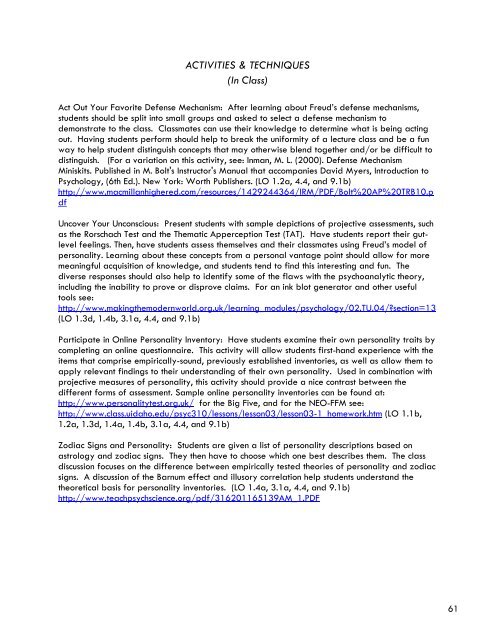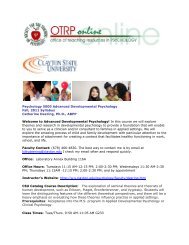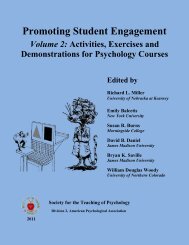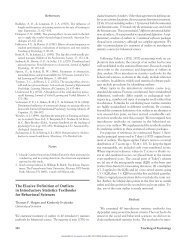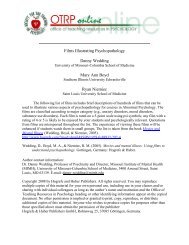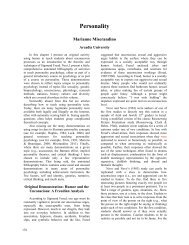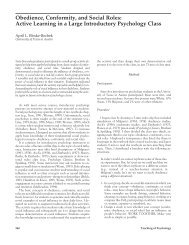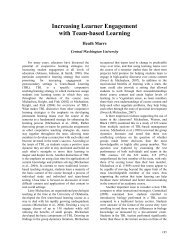INTRODUCTORY PSYCHOLOGY TEACHING PRIMER Early Career ...
INTRODUCTORY PSYCHOLOGY TEACHING PRIMER Early Career ...
INTRODUCTORY PSYCHOLOGY TEACHING PRIMER Early Career ...
You also want an ePaper? Increase the reach of your titles
YUMPU automatically turns print PDFs into web optimized ePapers that Google loves.
ACTIVITIES & TECHNIQUES<br />
(In Class)<br />
Act Out Your Favorite Defense Mechanism: After learning about Freud’s defense mechanisms,<br />
students should be split into small groups and asked to select a defense mechanism to<br />
demonstrate to the class. Classmates can use their knowledge to determine what is being acting<br />
out. Having students perform should help to break the uniformity of a lecture class and be a fun<br />
way to help student distinguish concepts that may otherwise blend together and/or be difficult to<br />
distinguish. (For a variation on this activity, see: Inman, M. L. (2000). Defense Mechanism<br />
Miniskits. Published in M. Bolt's Instructor's Manual that accompanies David Myers, Introduction to<br />
Psychology, (6th Ed.). New York: Worth Publishers. (LO 1.2a, 4.4, and 9.1b)<br />
http://www.macmillanhighered.com/resources/1429244364/IRM/PDF/Bolt%20AP%20TRB10.p<br />
df<br />
Uncover Your Unconscious: Present students with sample depictions of projective assessments, such<br />
as the Rorschach Test and the Thematic Apperception Test (TAT). Have students report their gutlevel<br />
feelings. Then, have students assess themselves and their classmates using Freud’s model of<br />
personality. Learning about these concepts from a personal vantage point should allow for more<br />
meaningful acquisition of knowledge, and students tend to find this interesting and fun. The<br />
diverse responses should also help to identify some of the flaws with the psychoanalytic theory,<br />
including the inability to prove or disprove claims. For an ink blot generator and other useful<br />
tools see:<br />
http://www.makingthemodernworld.org.uk/learning_modules/psychology/02.TU.04/?section=13<br />
(LO 1.3d, 1.4b, 3.1a, 4.4, and 9.1b)<br />
Participate in Online Personality Inventory: Have students examine their own personality traits by<br />
completing an online questionnaire. This activity will allow students first-hand experience with the<br />
items that comprise empirically-sound, previously established inventories, as well as allow them to<br />
apply relevant findings to their understanding of their own personality. Used in combination with<br />
projective measures of personality, this activity should provide a nice contrast between the<br />
different forms of assessment. Sample online personality inventories can be found at:<br />
http://www.personalitytest.org.uk/ for the Big Five, and for the NEO-FFM see:<br />
http://www.class.uidaho.edu/psyc310/lessons/lesson03/lesson03-1_homework.htm (LO 1.1b,<br />
1.2a, 1.3d, 1.4a, 1.4b, 3.1a, 4.4, and 9.1b)<br />
Zodiac Signs and Personality: Students are given a list of personality descriptions based on<br />
astrology and zodiac signs. They then have to choose which one best describes them. The class<br />
discussion focuses on the difference between empirically tested theories of personality and zodiac<br />
signs. A discussion of the Barnum effect and illusory correlation help students understand the<br />
theoretical basis for personality inventories. (LO 1.4a, 3.1a, 4.4, and 9.1b)<br />
http://www.teachpsychscience.org/pdf/316201165139AM_1.PDF<br />
61


